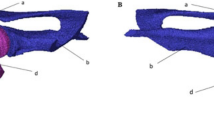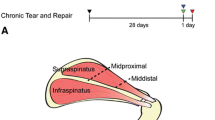Abstract
Purpose
Massive rotator cuff tears (MRCT) are usually chronic lesions that present associated degenerative changes of the myotendinous unit that have been implicated in limitations for surgical repair. In order to develop effective therapies, it is important to establish animal models that mimic the hallmarks of the injury itself. Therefore, in the present work, we aimed to (1) optimize a rodent animal model of MRCT that closely reproduces the fatty infiltration of the cuff muscles seen in humans and (2) describe the effects of unilateral or bilateral lesion in terms of histology and behaviour.
Methods
Massive tear was defined as two rotator cuff tendons—supraspinatus and infraspinatus—section. Twenty-one Wistar rats were randomly assigned to four groups: bilateral lesion (five animals), right-sided unilateral lesion (five animals), left-sided unilateral lesion (five animals) and control (six animals). Behaviour was analyzed with open field and staircase test, 16 weeks after lesion. After that, animals were killed, and the supraspinatus and infraspinatus muscles were processed.
Results
Histologic analysis revealed adipocytes, fatty infiltration and atrophy in the injured side with a greater consistency of these degenerative changes in the bilateral lesion group. Behaviour analysis revealed a significant functional impairment of the fine motor control of the forepaw analyzed in staircase test where the number of eaten pellets was significantly higher in sham animals (sham = 7 ± 5.0; left unilateral = 2.6 ± 3.0; right unilateral = 0 ± 0; and bilateral = 0 ± 0, p < 0.05). A trend to reach a lower level of steps, in more injured animals, was also observed (sham animals = 3 ± 1.6 > left unilateral = 2 ± 2.1 > right unilateral = 0.8 ± 1.3 > bilateral = 0.8 ± 1.1).
Conclusions
The present study has been able to establish an animal model that disclosed the hallmarks of MRCT. This can now be used as a valuable, cost-effective, pre-clinical instrument to assist in the development of advanced tissue engineered strategies. Moreover, this animal model overcomes some of the limitations of those that have been reported so far and thus represents a more reliable source for the assessment of future therapeutic strategies with potential clinical relevance.








Similar content being viewed by others
References
Albritton MJ, Graham RD, Richards RS 2nd, Basamania CJ (2003) An anatomic study of the effects on the suprascapular nerve due to retraction of the supraspinatus muscle after a rotator cuff tear. J Shoulder Elbow Surg 12(5):497–500
Asami A, Sonohata M, Morisawa K (2000) Bilateral suprascapular nerve entrapment syndrome associated with rotator cuff tear. J Shoulder Elbow Surg 9(1):70–72
Barton ER, Gimbel JA, Williams GR, Soslowsky LJ (2005) Rat supraspinatus muscle atrophy after tendon detachment. J Orthop Res 23(2):259–265
Benson RT, McDonnell SM, Knowles HJ, Rees JL, Carr AJ, Hulley PA (2010) Tendinopathy and tears of the rotator cuff are associated with hypoxia and apoptosis. J Bone Joint Surg Br 92(3):448–453
Boykin RE, Friedman DJ, Higgins LD, Warner JJ (2010) Suprascapular neuropathy. J Bone Joint Surg Am 92(13):2348–2364
Burkhart SS (1991) Arthroscopic treatment of massive rotator cuff tears. Clinical results and biomechanical rationale. Clin Orthop Relat Res 267:45–56
Carpenter JE, Hankenson KD (2004) Animal models of tendon and ligament injuries for tissue engineering applications. Biomaterials 25(9):1715–1722
Chang CH, Chen CH, Su CY, Liu HT, Yu CM (2009) Rotator cuff repair with periosteum for enhancing tendon-bone healing: a biomechanical and histological study in rabbits. Knee Surg Sports Traumatol Arthrosc 17(12):1447–1453
Cofield RH, Parvizi J, Hoffmeyer PJ, Lanzer WL, Ilstrup DM, Rowland CM (2001) Surgical repair of chronic rotator cuff tears. A prospective long-term study. J Bone Joint Surg Am 83-A(1):71–77
Coleman SH, Fealy S, Ehteshami JR, MacGillivray JD, Altchek DW, Warren RF, Turner AS (2003) Chronic rotator cuff injury and repair model in sheep. J Bone Joint Surg Am 85-A(12):2391–2402
Constant CR, Murley AH (1987) A clinical method of functional assessment of the shoulder. Clin Orthop Relat Res 214:160–164
Costouros JG, Porramatikul M, Lie DT, Warner JJ (2007) Reversal of suprascapular neuropathy following arthroscopic repair of massive supraspinatus and infraspinatus rotator cuff tears. Arthroscopy 23(11):1152–1161
DeOrio JK, Cofield RH (1984) Results of a second attempt at surgical repair of a failed initial rotator-cuff repair. J Bone Joint Surg Am 66(4):563–567
Dourte LM, Perry SM, Getz CL, Soslowsky LJ (2010) Tendon properties remain altered in a chronic rat rotator cuff model. Clin Orthop Relat Res 468(6):1485–1492
Ellera Gomes JL, da Silva RC, Silla LM, Abreu MR, Pellanda R (2012) Conventional rotator cuff repair complemented by the aid of mononuclear autologous stem cells. Knee Surg Sports Traumatol Arthrosc 20(2):373–377
Fuchs B, Weishaupt D, Zanetti M, Hodler J, Gerber C (1999) Fatty degeneration of the muscles of the rotator cuff: assessment by computed tomography versus magnetic resonance imaging. J Shoulder Elbow Surg 8(6):599–605
Gerber C, Fuchs B, Hodler J (2000) The results of repair of massive tears of the rotator cuff. J Bone Joint Surg Am 82(4):505–515
Gerber CMD, Nuss KM, Farshad M (2011) Anabolic steroids reduce muscle damage caused by rotator cuff tendon release in an experimental study in rabbits. J Bone Joint Surg Am 93(23):2189–2195
Gerber C, Meyer DC, Schneeberger AG, Hoppeler H, von Rechenberg B (2004) Effect of tendon release and delayed repair on the structure of the muscles of the rotator cuff: an experimental study in sheep. J Bone Joint Surg Am 86(9):1973–1982
Gerber C, Wirth SH, Farshad M (2011) Treatment options for massive rotator cuff tears. J Shoulder Elbow Surg 20(2 Suppl):S20–S29
Gimbel JA, Van Kleunen JP, Mehta S, Perry SM, Williams GR, Soslowsky LJ (2004) Supraspinatus tendon organizational and mechanical properties in a chronic rotator cuff tear animal model. J Biomech 37(5):739–749
Gladstone JN, Bishop JY, Lo IK, Flatow EL (2007) Fatty infiltration and atrophy of the rotator cuff do not improve after rotator cuff repair and correlate with poor functional outcome. Am J Sports Med 35(5):719–728
Goutallier D, Postel JM, Bernageau J, Lavau L, Voisin MC (1994) Fatty muscle degeneration in cuff ruptures. Pre- and postoperative evaluation by CT scan. Clin Orthop Relat Res 304:78–83
Goutallier D, Postel JM, Gleyze P, Leguilloux P, Van Driessche S (2003) Influence of cuff muscle fatty degeneration on anatomic and functional outcomes after simple suture of full-thickness tears. J Shoulder Elbow Surg 12(6):550–554
Goutallier D, Postel JM, Lavau L, Bernageau J (1998) Influence of muscular degeneration of the supra- and infra-spinatus on the prognosis of surgical repair of the rotator cuff. Acta Orthop Belg 64(Suppl 2):42–45
Goutallier D, Postel JM, Lavau L, Bernageau J (1999) Impact of fatty degeneration of the supraspinatus and infraspinatus muscles on the prognosis of surgical repair of the rotator cuff. Rev Chir Orthop Reparatrice Appar Mot 85(7):668–676
Gulotta LV, Kovacevic D, Packer JD, Deng XH, Rodeo SA (2011) Bone marrow-derived mesenchymal stem cells transduced with scleraxis improve rotator cuff healing in a rat model. Am J Sports Med 39(6):1282–1289
Kim HM, Galatz LM, Lim C, Havlioglu N, Thomopoulos S (2012) The effect of tear size and nerve injury on rotator cuff muscle fatty degeneration in a rodent animal model. J Shoulder Elbow Surg 21(7):847–858
Lee HJ, Kim YS, Ok JH, Song HJ (2013) Apoptosis occurs throughout the diseased rotator cuff. Am J Sports Med 41(10):2249–2255
Liem D, Lichtenberg S, Magosch P, Habermeyer P (2007) Magnetic resonance imaging of arthroscopic supraspinatus tendon repair. J Bone Joint Surg Am 89(8):1770–1776
Liu X, Laron D, Natsuhara K, Manzano G, Kim HT, Feeley BT (2012) A mouse model of massive rotator cuff tears. J Bone Joint Surg Am 94(7):e41
Liu X, Manzano G, Kim HT, Feeley BT (2011) A rat model of massive rotator cuff tears. J Orthop Res 29(4):588–595
Mallon WJ, Wilson RJ, Basamania CJ (2006) The association of suprascapular neuropathy with massive rotator cuff tears: a preliminary report. J Shoulder Elbow Surg 15(4):395–398
Mannava S, Plate JF, Tuohy CJ, Seyler TM, Whitlock PW, Curl WW, Smith TL, Saul KR (2013) The science of rotator cuff tears: translating animal models to clinical recommendations using simulation analysis. Knee Surg Sports Traumatol Arthrosc 21(7):1610–1619
Mellado JM, Calmet J, Olona M, Esteve C, Camins A, Perez Del Palomar L, Gine J, Sauri A (2005) Surgically repaired massive rotator cuff tears: MRI of tendon integrity, muscle fatty degeneration, and muscle atrophy correlated with intraoperative and clinical findings. AJR Am J Roentgenol 184(5):1456–1463
Meyer DC, Lajtai G, von Rechenberg B, Pfirrmann CW, Gerber C (2006) Tendon retracts more than muscle in experimental chronic tears of the rotator cuff. J Bone Joint Surg Br 88(11):1533–1538
Montoya CP, Campbell-Hope LJ, Pemberton KD, Dunnett SB (1991) The “staircase test”: a measure of independent forelimb reaching and grasping abilities in rats. J Neurosci Methods 36(2–3):219–228
Murrell GA, Lilly EG, Davies H, Best TM, Goldner RD, Seaber AV (1992) The Achilles functional index. J Orthop Res 10(3):398–404
Perry SM, Getz CL, Soslowsky LJ (2009) Alterations in function after rotator cuff tears in an animal model. J Shoulder Elbow Surg 18(2):296–304
Prut L, Belzung C (2003) The open field as a paradigm to measure the effects of drugs on anxiety-like behaviors: a review. Eur J Pharmacol 463(1–3):3–33
Rubino LJ, Stills HF Jr, Sprott DC, Crosby LA (2007) Fatty infiltration of the torn rotator cuff worsens over time in a rabbit model. Arthroscopy 23(7):717–722
Safran O, Derwin KA, Powell K, Iannotti JP (2005) Changes in rotator cuff muscle volume, fat content, and passive mechanics after chronic detachment in a canine model. J Bone Joint Surg Am 87(12):2662–2670
Soslowsky LJ, Carpenter JE, DeBano CM, Banerji I, Moalli MR (1996) Development and use of an animal model for investigations on rotator cuff disease. J Shoulder Elbow Surg 5(5):383–392
Sousa N, Almeida OF, Wotjak CT (2006) A hitchhiker’s guide to behavioral analysis in laboratory rodents. Genes Brain Behav 5(Suppl 2):5–24
Tauro JC (2006) Stiffness and rotator cuff tears: incidence, arthroscopic findings, and treatment results. Arthroscopy 22(6):581–586
Thomazeau H, Rolland Y, Lucas C, Duval JM, Langlais F (1996) Atrophy of the supraspinatus belly. Assessment by MRI in 55 patients with rotator cuff pathology. Acta Orthop Scand 67(3):264–268
Van Zutphen LFM, Baumans V, Beynen A (2001) Principles of laboratory animal science. Elsevier, Amsterdam
Warner JP, Krushell RJ, Masquelet A, Gerber C (1992) Anatomy and relationships of the suprascapular nerve: anatomical constraints to mobilization of the supraspinatus and infraspinatus muscles in the management of massive rotator-cuff tears. J Bone Joint Surg Am 74(1):36–45
Zingg PO, Jost B, Sukthankar A, Buhler M, Pfirrmann CW, Gerber C (2007) Clinical and structural outcomes of nonoperative management of massive rotator cuff tears. J Bone Joint Surg Am 89(9):1928–1934
Zumstein MA, Jost B, Hempel J, Hodler J, Gerber C (2008) The clinical and structural long-term results of open repair of massive tears of the rotator cuff. J Bone Joint Surg Am 90(11):2423–2431
Acknowledgments
Portuguese Foundation for Science and Technology (FCT) (FCT Development Grant to A.J. Salgado). This work was also co-funded by Programa Operacional Regional do Norte (ON.2—O Novo Norte), ao abrigo do Quadro de Referência Estratégico Nacional (QREN), através do Fundo Europeu de Desenvolvimento Regional (FEDER).
Conflict of interest
The authors declare that they have no conflict of interest.
Author information
Authors and Affiliations
Corresponding author
Rights and permissions
About this article
Cite this article
Sevivas, N., Serra, S.C., Portugal, R. et al. Animal model for chronic massive rotator cuff tear: behavioural and histologic analysis. Knee Surg Sports Traumatol Arthrosc 23, 608–618 (2015). https://doi.org/10.1007/s00167-014-3441-3
Received:
Accepted:
Published:
Issue Date:
DOI: https://doi.org/10.1007/s00167-014-3441-3




